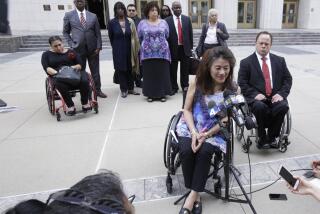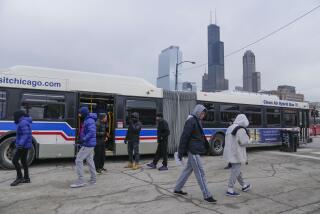Mediator Rules Against MTA on Bus Crowding
- Share via
A mediator has ruled that the Metropolitan Transportation Authority’s bus service does not meet the strict standards on overcrowding established in a federal agreement.
The MTA and the Bus Riders Union, lead plaintiff in the federal consent decree that forced massive improvements to the countywide bus system, have clashed since 1996 over whether the transit agency is limiting the number of people forced to stand on crowded buses, as it agreed to do.
The clash has played out in numerous courtrooms, with the MTA repeatedly appealing the consent decree only to be rebuked by federal judges and, in March, the state Supreme Court.
On Tuesday, Donald Bliss, the Washington lawyer appointed to mediate the dispute, issued a ruling stating that the MTA has violated overcrowding standards on at least 68 bus lines over the last two years.
Bliss’ ruling was based on statistics provided by the Bus Riders Union and the MTA, in addition to a memo acknowledging overcrowding on the lines signed last week by representatives of both sides.
The riders’ organization praised the ruling, characterizing the MTA as deceitful and uninterested in the best interests of its core customers: low-income bus riders. As he has done repeatedly, Union director Eric Mann said the MTA buses are “massively overcrowded” and called for 250 more buses to be put on the street.
The MTA downplayed the ruling. A spokesman said the agency’s bus service is much improved, partly because of the consent decree. He pointed to the near-total replacement of an aging fleet of nearly 2,200 buses with new vehicles and the fact that most lines do not have significant overcrowding problems.
The MTA continues to reason that the overcrowding benchmarks do not represent a complete picture of what the bus system is like. “It’s just impossible not to have too many people standing at certain times,” said Marc Littman, an MTA spokesman.
Far more important than the haggle over whether eight or 11 people on average are standing on MTA’s rush-hour buses is the next step: what to do about it.
Bliss has directed both sides to study why buses are too crowded and then give him recommendations on how to solve the problem. If the two sides fail to come to an agreement, Bliss will step in to offer his own solution sometime in the next three to four months.
More to Read
Sign up for Essential California
The most important California stories and recommendations in your inbox every morning.
You may occasionally receive promotional content from the Los Angeles Times.














